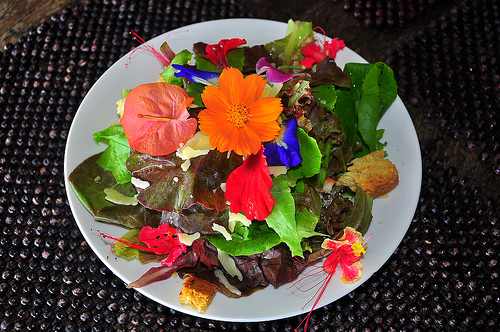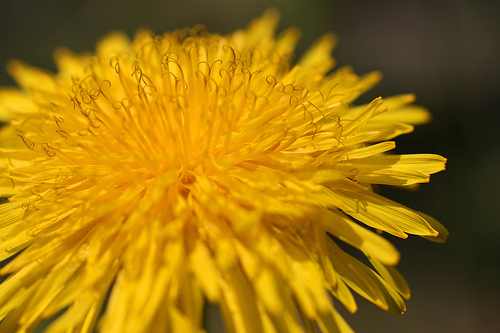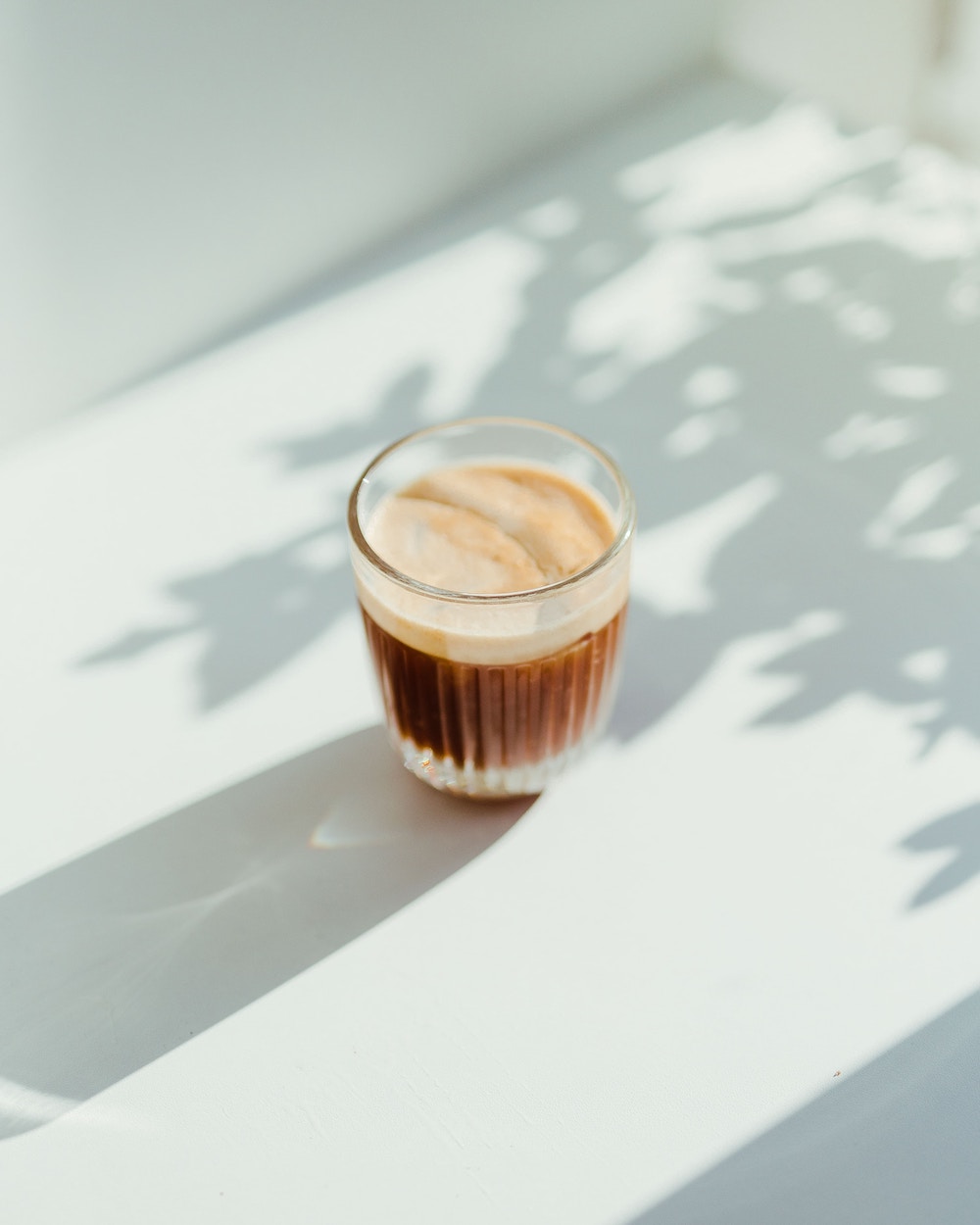
Adding edible flowers can bring a little fancy flare to your cooking and baking. You can really take a salad up a notch by adding eye-catching pansies, or make desserts taste gourmet by adding a little rose essence. With spring right around the corner, I know I’m itching to try some edible flowers. Even though there are a lot to choose from, the following are flowers I would be most interested in trying. Many of these have an ancient history of culinary and medicinal use. I also found that quite a few had high nutritional value. So let’s get cookin’!
1. Marigolds- These vibrant little beauties are good in soups, rice dishes, and salads. Since the color is so vibrant you will often see dried marigolds made into a “poor man’s” substitute for saffron. The petals have a strong, spicy flavor while the leaves are bitter. They contain carotene which can be converted to vitamin A in the body, so not only are they pretty but they are nutritious for you too!
2. Chrysanthemum- These yellow or white flowers of the species C. morifolium can be boiled to make sweet teas, which are widespread throughout Asia, especially in China, where Chinese herbal medicine uses such teas to cure sore throats and fever. A nutritionally dense flower, they are a rich source of vitamins A, B6, C , K, riboflavin and thiamine. They are also rich in calcium, magnesium, folate, iron, sodium, potassium, phosphorous, maganese, zinc and copper(that’s quite a list!) Chrysanthemums are especially popular in Asian cuisine such as soups, stews, hot pots, casserole dishes and stir fries.
3. Dandelion- Not just a lowly weed found in your backyard! Dandelions are versatile and are high in nutrition. The leaves resemble mustard greens in taste and are high in vitamin A, C, and iron (they actually have more iron than spinach.) The leaves can be eaten raw in salads(which is actually really tasty) or used in place of other greens in soups. Flowers can be used to make wine, jam, and even a honey substitute. Grind and roast the roots and use a as coffee substitute.

4. Sunflowers- We all know that you can eat parts of the sunflower. But they are so pretty, and such a symbol of warm weather and summer, that I felt the need to include them in this list. Sunflower oil and seeds can be used in a variety of ways. Oil can be used for various things such as frying or in salad dressings. The seeds are an awesome snack or topping for breads, salads and soups. The seeds are also a great source of nutrition. They are especially high in vitamin D, B, niacin, and protein. Sunflowers have also been used in medicinal practices in ancient South American, Native American, and Russian cultures.
5. Rose– The majestic rose. This is my favorite flower of all, with complex arrangement of petals and unmistakable aroma. Now you can eat it too! The petals, hips, and leaves are all fit for consumption. The hips contain 2000mg of vitamin C per 100g of raw fruit (and they are nutritious? Get out of town!). The leaves are good brewed in tea. Rose hips can be made into vinegar or jams. The petals are most often seen in fancy, schmancy desserts but now you have the power of adding them to your everyday baking to give it some upscale flare. Try using rose water (it is to die for in cookies and cupcakes), rose extract and rose liquor.
6. Pansy- You can eat the whole flower! No kidding! They can have a grassy, tangy flavor or minty flavor that goes well with desserts, greens, rice and lentils. Try infusing crushed pansies with olive oil for a unique flavor. Pansies can also be candied and make pretty garnishes for cakes and hor d’oeuvres. Dying to make vegan artisanal cheeses (I know I am) and have a fancy wine and cheese night? Now is your chance to create a beautiful cheese platter since pansies look pretty and go well with most cheeses.
7. Lavender- Just remember a little goes a long way. You can add buds to homemade Herbs de Provence for a unique flavor. Grind lavender in coffee grinder or mortar and pestle to release the aroma and oils, then add to savory dishes such as tomato sauces, hearty stews, and wine reduced sauces. Add lavender to sugar, seal it and let sit for a few weeks for lavender infused sugar to add to pretty little pastries. Got a wedding to attend this spring? Lavender makes a beautiful addition to a glass of champagne.
8. Jasmine (Jasmine officionale)- My love for jasmine comes in second only to my love for roses. The scent is amazing, which makes this flower awesome for a soothing tea. It can be reduced down to essential oil, which is easily incorporated into various dishes. Jasmine is mostly used in Thai cuisine and makes a great addition to rice.
9. Gardenia– Here is another one of those versatile flowers. The leaves, flowers, and fruit have been used in Chinese herbal medicine all over Asia. Gardenia is known as a happiness herb, since it helps detoxify the liver which is believed to release negative emotions. Gardenia tea has been used to help detoxify the blood, relieve congestion, and help lower LDL. Add this gorgeous creamy blossom to salads, or as a garnish; the fruits can even be eaten out of hand. Gardenia is prized for its soft-yellow petals and is another flower that can also be used as a less expensive substitute for saffron.
10. Hibiscus- Native to tropical and subtropical regions, hibiscus are brightly colored with a distinctly tangy flavor and a great source of vitamin C. Use your imagination and add these little gems to salads, then let your mind whisk you away to a long, lost beach somewhere, where hibiscus grow in plenty. The buds can be pickled or boiled and used as a vegetable. The petals can be made into tea or stuffed and made into fritters. Hibiscus can also be dried, candied, and baked into cakes for added flare and decoration. Don’t forget to also try hibiscus infused into cocktails!

Things to Keep In Mind-
Not all flowers are edible, and many can be poisonous. Make sure to read up and do research on usable flowers before incorporating into any dishes.
ONLY consume flowers sold in food markets or grown organically yourself. This ensures that they are fit for consumption and are not loaded with pesticides.
Make sure to wash your edible flower thoroughly.
Be extra cautious if you have allergies to pollen.
Also by Krystle: 12 Amazing Uses of Essential Oils
Healing Ingredients: What is Kombucha?
Is Soy Safe? 5 Things You Didn’t Know About Soy
__
Photos: Courtesy of Flickr:
Flower Salad-whologwhy
Dandelion- Fimb
Hibiscus- Chobist




